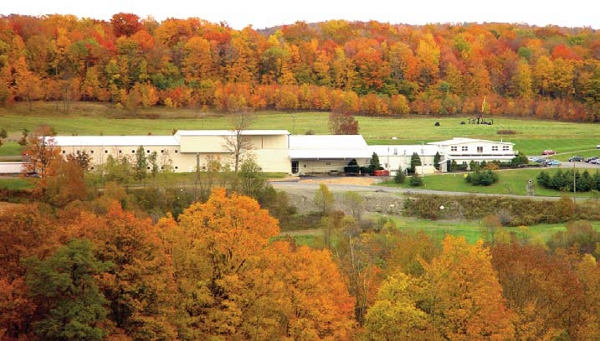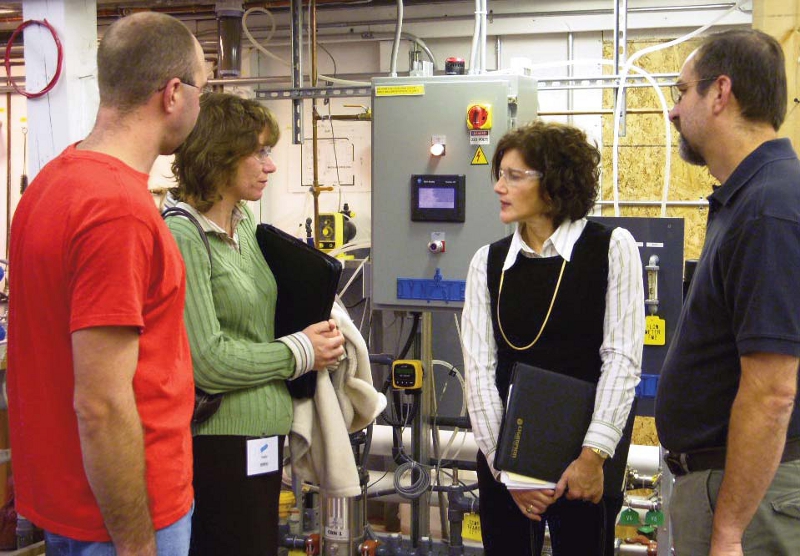By Ben Gavett

Dedicating resources to environmental stewardship has been an important company focus since 1980.
Water, nature’s universal solvent, is the most common and most vital compound on Earth. However, even though water covers the majority of our planet’s surface, the increasing scarcity of potable fresh water is of growing concern in many regions of the world. In addition to nourishment, many other uses compete for its supply, including the manufacture of acrylic paint.
Water is the single most common component in the paint we make. Water in acrylic paints and mediums carries the polymer, pigment and additives, maintaining them in a useful state until application, whereupon it evaporates. Beyond our need for water as a paint ingredient, we need about a gallon of it to clean the production equipment and tools used for each gallon of paint we manufacture. Ultimately, both the water that evaporates from the paint during drying and that which we use for cleaning returns to the ecosystem. It disallows us from taking for granted its supply or from being apathetic to its future; to do so would be irresponsible. It is in this spirit that we long ago began pursuit of a goal to constantly improve our practices relative to the preservation and reuse of water in our products and processes.
We have made a significant advancement, just this past summer, in our efforts to achieve greater recycling of our precious water resources. We installed a Reverse Osmosis (RO) filtering system that allows us to reuse over two-thirds of our cleaning water each day. While not the endpoint of the zero discharge future we envision, it is a giant innovative step forward. These goals have been pursued over years, through research, testing and financial support from the Environmental Services Unit of the New York State Department of Economic Development.
Our wastewater treatment process still begins with a primary step where the murky wash water is flocculated and filtered to remove solids, resulting in a sludge comprised of acrylic, pigments, and diatomaceous earth filter media. The filtrate from this is remarkably clear, but is not clean. High levels of dissolved organic molecules remain. These are the remnants of the complex array of raw materials needed to produce acrylic paint, and include surfactants, glycols, and preservatives; all invisible but measurable in units of Biological and Chemical Oxygen Demand (BOD/COD). After this primary filtration, the water looks clean enough to reuse for cleaning, but isn’t, because a significant amount of skin contact and inhalation of water mist is typical in washing the paint-making equipment. Instead, our practice has been to send all of this water, via tanker truck, to the city treatment works 20 miles distant, where the BOD/COD is eliminated through aerobic and anaerobic bacterial degradation.

Using reverse osmosis to further filter the water allows us to concentrate the impurities and recover about 70 percent of the water for reuse, proportionately reducing the fuel needed for transportation, as well as the resultant diesel exhaust, taking a moderate bite out of our carbon footprint. It also directly decreases our groundwater withdrawals by the amount we are able to reuse due to this new filtration step.
Our current level of performance in this area has been achieved through a process of innovative problem solving. But unlike making a new product for delighting our customer, the goal of this effort is to recognize the responsibility of every business…of every person…to view their impact in a much larger context and to make a change. We realize that we still have many opportunities ahead to achieve greater environmental stewardship, but through a steady commitment, focus and innovation we will continue to make a difference.
About Ben Gavett
View all posts by Ben Gavett -->Subscribe
Subscribe to the newsletter today!
No related Post
